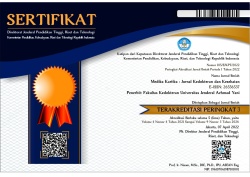KEMANFAATAN DATA AUTOPSI VERBAL HEALTH AND DEMOGRAPHIC SURVEILLANCE SYSTEM (HDSS) SLEMAN DALAM MEMPERKIRAKAN SEBAB DAN CARA KEMATIAN
Abstract
Kematian terjadi dimana saja, dengan atau tanpa saksi, dengan atau tanpa didahului perawatan oleh tenaga kesehatan. Pencatatan kematian yang baik dan lengkap memenuhi kebutuhan informasi yang berguna bagi perlindungan hak asasi manusia, peningkatan upaya keselamatan masyarakat, dan pengambilan kebijakan di bidang kesehatan dan kependudukan. Analisis faktor risiko dan tanda serta gejala yang diamati sebelum kematian memberikan informasi yang berguna untuk memperkirakan penyakit atau penyebab kematian. Sehubungan dengan hal tersebut perlu digali data autopsi verbal sebagai upaya perlindungan hukum masyarakat dan statistik kesehatan. Penelitian ini menggunakan desain observasional. Data yang digunakan adalah data sekunder Health and Demographic Surveillance System (HDSS) Sleman. Subjek penelitian adalah seluruh kematian yang tercatat dalam dokumen autopsi verbal HDSS Sleman, pada tahun 2014-2018, sejumlah 687 kasus. Analisis statistik yang digunakan analisis deskriptif kematian. Terdapat perbedaan yang bermakna proporsi gender, pada tahun 2014 dan 2017, kematian perempuan lebih banyak dari laki-laki. Sebagian besar kematian pada umur di atas 65 tahun. Kematian sebagian besar adalah kematian wajar. Kematian tidak wajar disebabkan oleh kecelakaan lalu lintas, tenggelam, terbunuh dan lain-lainnya, tertinggi pada tahun 2014 (12%). Kematian yang belum dapat ditentukan (indeterminate) terdapat di setiap tahunnya, terbesar pada tahun 2017 (13%). Kematian terbesar setiap tahun adalah kematian akibat stroke (29%). Kematian akibat infeksi paling banyak disebabkan infeksi saluran nafas. Kematian akibat kanker sebesar 12% dengan penyebab terbanyak adalah kanker pencernaan (25 kasus). Kematian akibat gangguan metabolik terbanyak adalah diabetes melitus (32 kasus dari 55 kasus).
References
2. James, J P., Jones, R., Karch, S B., Manlove, J. 2011. Simpson’s Forensic Medicine. 13rd edition. Hodder & Stoughton Ltd. London.
3. Wahab A, Choiriyyah I, dan Wilopo SA. 2017. Determining the Cause of Death: Mortality Surveillance Using Verbal Autopsy in Indonesia. https://www.ncbi.nlm.nih.gov/pubmed/29016331, Am J Trop Med Hyg. 2017 Nov;97(5):1461-1468
4. Herbst et al., 2011, Verbal autopsy-based cause-specific mortality trends in rural KwaZulu- Natal, South Africa, 2000-2009, Population Health Metrics 2011, 9:47 http://www.pophealthmetrics.com/content/9/1/47.
5. Suhartini, Beta Ahlam Gizela, Vena Jaladara, 2019. Profil sebab kematian berdasarkan data verbal autopsy di Kabupaten Sleman tahun 2016-2018. Muktamar & PIT PDFI 2019. Yogyakarta, 19-21 September 2019. www.muktamar.pdfi2019.com/ Kumar, S., & Verma, A. 2013. A study of elderly unnatural deaths in medico-legal autopsies at Lucknow locality. Medicine, Science and the Law, 54(3), 127–131.
6. Vadysinghe, A., Senasinghe, P., Sivasubramanium, M., Jayasooriya, P., Premarathna, B., Rathnayake, R. and Wickramasinghe, W. 2018. Unnatural Deaths of the Elderly Population of Sri Lanka: A Descriptive Analysis. The American Journal of Forensic Medicine and Pathology, 39(2), pp.148-151.
7. Bhamkar, R., Seth, B. and Setia, M. 2016. Profile and Risk Factor Analysis of Unintentional Injuries in Children. The Indian Journal of Pediatrics, 83(10), pp.1114-1120.
8. Swaen GMH, van Amelsvoort LGPM, Bültmann U, et al. Fatigue as a risk factor for being injured in an occupational accident: results from the Maastricht Cohort Study. Occupational and Environmental Medicine 2003;60:i88-i92.
9. Ryb, G., Cooper, C., Dischinger, P., Kufera, J., Auman, K. and Soderstrom, C. 2009. Suicides, Homicides, and Unintentional Injury Deaths After Trauma Center Discharge: Cocaine Use as a Risk Factor. The Journal of Trauma: Injury, Infection, and Critical Care, 67(3), pp.490-497.
10. Tumram, N., Ambade, V. and Dixit, P. 2017. Human fatalities caused by animal attacks: A six-year autopsy study. Medico-Legal Journal, 85(4), pp.194-199.
11. Roshanfekr P, Afzali Ardakani HM, Sajjadi H, Khodaei-Ardakani MR. 2019 .Social differences in the prevalence of road traffic injuries among pedestrians, and vehicle and motorcycle users in Iran: Results of a national multiple indicator demographic and health survey Int J Prev Med 2019;10:98
12. Malik, R., Atif, I., Rashid, F., & Abbas, M. 2017. An analysis of 3105 Medico Legal Cases at Tertiary Care Hospital, Rawalpindi. Pakistan Journal of Medical Sciences, 33(4)
13. Badan Pusat Statistik. 2017. Jumlah Kecelakaan, Korban Mati, Luka Berat, Luka Ringan, dan Kerugian Materi yang Diderita Tahun 1992-2017. [online] Available at: https://www.bps.go.id/linkTableDinamis/view/id/1134 [Diakses 23 Feb. 2019].
14. Pal, C., Hirayama, S., Narahari, S., Jeyabharath, M., Prakash, G., & Kulothungan, V. 2018. An insight of World Health Organization (WHO) accident database by cluster analysis with self-organizing map (SOM). Traffic Injury Prevention, 19(sup1), S15–S20
15. ILO. 2005. Facts on Safety at Work. International Labour Organization. https://www.ilo.org/wcmsp5/groups/public/---dgreports/---dcomm/documents/publication/wcms_067574.pdf. Diakses pada 20 November, 2019.
16. Hartley, L.R., Arnold, P. K. 1996. Recommendations from the Second International Conference on Fatigue in Transportation, Fremantle, Western Australia,. Fremantle, Institute for Safety and Transport, Murdoch University, Western Australia, 1996 (Report 113)
17. Marzano , M., Fazel , S., Rivlin, A., & Hawton, K. 2011. Near-lethal self-harm in women prisoners: contributing factors and psychological processes. Pages 863-884. https://doi.org/10.1080/14789949.2011.617465
18. World Health Organization. 2014. Preventing suicide. Geneva: World Health Organization.
19. Kim, J., Jung, H., Won, D., Shin, Y., Noh, J. and Kang, T. 2018. Landscape of Elderly Suicide in South Korea: Its Trend According to Age, Gender, and Educational Attainment. OMEGA - Journal of Death and Dying, p.003022281880784.
20. Izadi, N., Mirtorabi, S., Najafi, F., Nazparvar, B., Nazari Kangavari, H. and Hashemi Nazari, S. 2018. Trend of years of life lost due to suicide in Iran (2006–2015). International Journal of Public Health, 63(8), pp.993-1000.
21. Singh, B., Chettri, R. and Gurung, J. 2016. A 10-year retrospective study of suicide in Sikkim, India: Sociodemographic profile and risk assessment. Indian Journal of Psychiatry, 58(4), p.448.
22. Mirahmadizadeh, A., Rezaei, F., Mokhtari, A., Gholamzadeh, S. and Baseri, A. (2019). Epidemiology of suicide attempts and deaths: a population-based study in Fars, Iran (2011–16). Journal of Public Health.
23. Donath, C., Bergmann, M., Kliem, S., Hillemacher, T. and Baier, D. 2019. Epidemiology of suicidal ideation, suicide attempts, and direct self-injurious behavior in adolescents with a migration background: a representative study. BMC Pediatrics, 19(1).
24. Pompili, M., Innamorati, M., Di Vittorio, C., Baratta, S., Masotti, V., Badaracco, A., Amore, M. 2014. Unemployment as a Risk Factor for Completed Suicide: A Psychological Autopsy Study. Archives of Suicide Research, 18(2), 181–192
25. Sargeant, H., Forsyth, R. and Pitman, A. 2018. The Epidemiology of Suicide in Young Men in Greenland: A Systematic Review. International Journal of Environmental Research and Public Health, 15(11), p.2442.
26. Mishra, K., Gupta, N. and Bhabulkar, S. 2015. Sociodemographic profile of suicide attempters among the rural agrarian community of central India. Industrial Psychiatry Journal, 24(2), p.185.
27. Qin, P. 2005. Suicide risk in relation to level of urbanicity—a population-based linkage study. International Journal of Epidemiology, 34(4), pp.846-852.
28. Kim, C., Cho, Y. 2017. Does Unstable Employment Have an Association with Suicide Rates among the Young?. Int J Environ Res Public Health. 14(5): 470
29. Fukuchi, N., Kakizaki, M., Sugawara, Y., Tanji, F., Watanabe, I., Fukao, A., & Tsuji, I. 2013. Association of marital status with the incidence of suicide: A population-based Cohort Study in Japan (Miyagi cohort study). J Affect Disord, 150(3), 879–885
30. Vijayakumar, L. 2015. Suicide in Women. Indian J Psychiatry. 57(Suppl 2): S
31. Drucker, J. 2011. Risk Factors of Murder and Non‐Negligent Manslaughter. RTM Insights, 15. Available at www.riskterrainmodeling.com
32. Ogum Alangea, D., Addo-Lartey, A., Sikweyiya, Y., Chirwa, E., Coker-Appiah, D., Jewkes, R. and Adanu, R. 2018. Prevalence and risk factors of intimate partner violence among women in four districts of the central region of Ghana: Baseline findings from a cluster randomised controlled trial. PLOS ONE, 13(7), p.e0200874.
33. Butchart, A., Garcia-Moreno, C. and Mikton, C. 2010. Preventing intimate partner and sexual violence against women. Geneva: World Health Organization.
34. Danesh, H A., Javanbakht, S., Nourallahzadeh, M., Bakhshani, N M., Danesh, S., Nourallahzadeh, F., Rezaei, F., and Otaghour, H A. 2019. Epidemiology and Mortality of Burn Injuries in Eastern Iran Since 2009: An analysis of 2115 Cases. International Journal of High Risk Behaviors and Addiction.
35. Undang-Undang Republik Indonesia Nomor 24 Tahun 2007 tentang Penanggulangan Bencana.
36. WHO, 2012. Verbal Autopsy Standards: 2012 WHO Verbal Autopsy Instrumen. WHO Library Cataloguing-in-Publication Data, pp. 3-5.
37. Kemenkes, 2017. KEPUTUSAN MENTERI KESEHATAN REPUBLIK INDONESIA NOMOR HK.01.07/MENKES/273/2017 TENTANG TIM VERIFIKASI KABUPATEN/KOTA SEHAT TINGKAT PUSAT. s.l.:Kementrian Kesehatan Republik Indonesia.
38. Kementerian Kesehatan Republik Indonesia. Potret Sehat Indonesia from Basic Health Research (RISKESDAS) 2018. [Online] Dapat diakses di: http://www.depkes.go.id/article/view/18110200003/potret-sehat-indonesia-dari-riskesdas-2018.html [Diakses 17 January 2019]




























